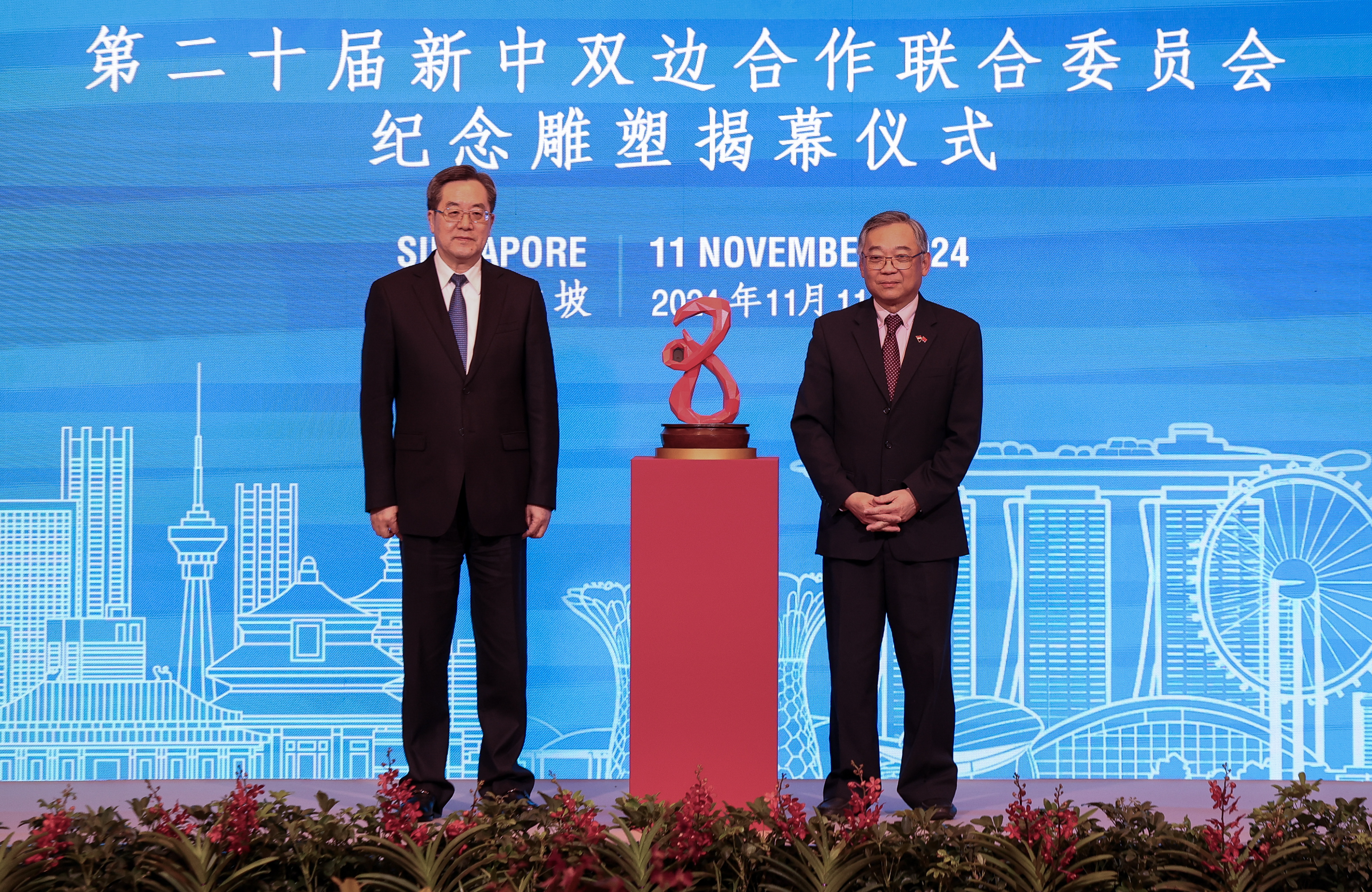Singapore and China sign 25 agreements at annual top-level bilateral meeting to boost cooperation
The agreements were signed at the 20th Joint Council for Bilateral Cooperation meeting, co-chaired by Singapore DPM Gan Kim Yong and Chinese Vice Premier Ding Xuexiang.


This audio is generated by an AI tool.
SINGAPORE: Singapore and China have signed 25 agreements at their annual apex meeting, boosting cooperation in areas like trade, finance and maritime as they strengthen ties amid a troubled geopolitical climate.
The slew of memoranda of understanding (MOUs) and agreements - up from 24 last year and the most in recent years - was unveiled on Monday (Nov 11) at the 20th Joint Council for Bilateral Cooperation (JCBC) meeting, held at the Shangri-La Hotel in Singapore.
Singapore Deputy Prime Minister Gan Kim Yong and visiting Chinese Vice Premier Ding Xuexiang co-chaired the meeting, which is the highest-level annual forum between China and Singapore.
Held alternately between the two countries, it reviews the substantive collaboration between them and charts the direction of cooperation.
“From our exchanges, it is clear that the upgrade of our relations last year … has given our bilateral agenda a renewed focus, one that is more ambitious and forward-looking,” said Mr Gan.
Singapore and China elevated bilateral ties last year to an “All-Round High-Quality Future-Oriented Partnership”, following a meeting between Singapore's then-Prime Minister Lee Hsien Loong and Chinese President Xi Jinping in Beijing.
Similarly, Mr Ding acknowledged the bilateral progress made over the years.
“China is willing to work with Singapore to further implement the important consensus reached by our leaders, focusing on comprehensive, high-quality, and forward-looking cooperation,” he said.
“We will continue to explore new connection points and areas of growth, bringing greater benefits to the people of both countries."
This was the first time Mr Gan - who is also minister for trade and industry - co-chaired the JCBC and related joint steering council meetings for the three Singapore-China government-to-government projects.
These projects are Suzhou Industrial Park, Tianjin Eco-City and the Chongqing Connectivity Initiative.

FIRMING UP COOPERATION AMID GEOPOLITICAL UNCERTAINTY
The previous JCBC co-chair for the Singapore side was Mr Lawrence Wong, who took the helm as prime minister in May.
The Singapore-China relationship is built on a basis of mutual interests and shared beliefs of cooperation, Mr Gan noted when speaking to Singapore media after the JCBC meeting.
Reflecting on the evolution of bilateral relations, Mr Gan emphasised the need for continuity in the Singapore-China relationship.
“With every new generation of leaders, you will need to refresh the relationship, you need to continue to strengthen the mutual understanding so that you can bring trust and confidence with one another,” he noted when speaking to Singapore media after the JCBC meeting,
This enduring trust, he added, has been crucial in shaping the shared goals discussed in the series of meetings under the JCBC.
He highlighted the need to take a longer-term view, pointing out that many of the agreements made during the forum will take time to implement and for the benefits to be realised.
“Connectivity is one example. We'll continue to build and strengthen the connectivity between Singapore and China, and to encourage China businesses to use Singapore as a gateway to the Asia, Southeast Asian markets, ASEAN market,” Mr Gan told reporters.
“This (will) require many years of hard work … to be able to bear fruit.”
Mr Gan was also asked how Singapore plans to navigate its trade strategy with China amid heightened geopolitical tensions and the tariff threats made by US President-elect Donald Trump.
While stressing the need to monitor how matters play out first, Mr Gan warned that the outlook and operating environment are likely to remain “very challenging” and continue to have “significant uncertainties”.
“From Singapore's point of view, being a small and open economy, we want to look forward to a more stable and secure relationship, and a constructive relationship between China and the US,” he told reporters.
“Therefore we will encourage the US and China to continue to have dialogue, to continue to find ways to work together even as they compete with one another.”
Against this backdrop, Mr Gan emphasised that Singapore businesses and leaders need to remain nimble and flexible. “(We need) to be prepared to adjust our strategy even as the global environment evolves,” he said.
MARKING A MILESTONE
A commemorative sculpture was unveiled to mark the 20th edition of the JCBC.
The 3D-printed resin sculpture is designed to resemble the numbers "2" and "0" when viewed from different angles, symbolising the two decades of collaboration between Singapore and China.
In a nod to this year's JCBC theme, "Vision 20/20, Charting the Future," the sculpture incorporates nano-sized inscriptions of it in both English and Chinese.
It was created by students and faculty from the Singapore University of Technology and Design (SUTD).

STRENGTHENING FINANCIAL COOPERATION
Bilateral financial cooperation will get a boost with several green finance and capital markets initiatives.
One tie-up between the Singapore and China central banks aims to catalyse green financing flows. The exercise, which compares the green criteria of the European Union, China and Singapore taxonomies, will be completed by the end of this year, the Monetary Authority of Singapore said in a press release on Monday.
“This will enable easier comparison of the green taxonomies of Singapore and China and facilitate the provision of cross-border green loans, green bond issuance and fund investments.”
MAS and the People’s Bank of China are also exploring a pilot with both countries’ banks to enhance international investors’ access to China’s bond market. It will leverage the existing “over-the-counter” bond market framework in China.
Other collaborations include discussions to expand the suite of products on the Exchange Traded Funds (ETF) Product Links between the Singapore Exchange and the Shenzhen and Shanghai bourses, as well as facilitating financial institutions’ access to Singapore and China markets.
FACILITATING TRADE AND INVESTMENTS
In trade, Singapore and China reiterated their commitment to the China-Singapore Free Trade Agreement (CSFTA) Further Upgrade Protocol, which is set to enter into force on Dec 31, 2024, said Singapore’s Ministry of Trade and Industry (MTI) in a separate press release.
The CSFTA is China’s first comprehensive bilateral free trade agreement with an Asian country. It came into force in 2009, and the latest planned enhancements were inked at last year’s JCBC.
Under them, Singapore investors and service suppliers can expect “more liberal and transparent rules” that level the playing field for them to invest in and trade with China, MTI said.
The ministry added that Singapore businesses will also benefit from greater market access to China through a “negative list” approach, where by default, all sectors are opened to investors except for those specifically listed.
“Notably, China commits to not limiting foreign equity limits for Singapore investors in 22 sectors such as construction, retailing & wholesale, and architectural & urban planning services,” MTI said.
Another agreement focuses on the joint promotion of the Belt and Road Initiative. It aims to strengthen Singapore and China’s collaboration in areas such as policy coordination, infrastructure connectivity, bilateral trade and people-to-people exchanges.
"(This) will provide clearer policy guidance for the next phase of high-quality Belt and Road development, further promoting the joint growth of China, Singapore, and regional countries," said Mr Ding.
Since 2013, Singapore has been China’s largest foreign investor in terms of investment flows, and China has been Singapore’s largest merchandise trading partner. Bilateral trade in 2023 amounted to US$108.39 billion, according to China’s foreign ministry.
ELEVATING MARITIME COOPERATION
On maritime cooperation, both countries are aiming to elevate cooperation on their green and digital shipping corridor (GDSC) initiatives to the national level.
“This will deepen cooperation and strengthen coordination between the maritime industries of both countries … (and) will also align efforts on decarbonisation, digitalisation, and workforce development,” MTI said.
Singapore and China currently have two GDSC agreements. The Singapore-Shandong tie-up was announced in October, while the Singapore-Tianjin collaboration was established last year.
“It aims to drive the adoption of green and digital solutions and the growth of the maritime industry between Singapore and the Bohai and Yellow Sea region,” MTI noted regarding the Singapore-Shandong GDSC.
As part of this, the Maritime and Port Authority of Singapore and the Shandong Provincial Transport Department will work with various stakeholders - including maritime companies, port operators and institutes of higher learning - to promote digital and low-carbon initiatives for shipping.
These include exploring tie-ups in areas like emerging technologies, alternative fuels and shore power technologies.
“FRONTRUNNER OF CHINA’S ECONOMIC DEVELOPMENT”
Suzhou Industrial Park - the first government-to-government project between Singapore and China - also took the limelight on Monday. The project is marking its 30th anniversary this year.
Singapore leaders have over the years referred to Suzhou Industrial Park as a “pathfinder” for bilateral cooperation. This point was reiterated during the JCBC meeting.

“I am heartened that 30 years after its establishment, (Suzhou Industrial Park) remains a frontrunner of China’s economic development,” said Mr Gan. He added that the project’s focus on the green economy and biomedical sciences is “closely aligned” with both countries’ priorities.
Both sides are finalising a 10-year blueprint to chart the next phase of development for the project, shared Mr Chan Chun Sing, the Singapore minister-in-charge of Suzhou Industrial Park.
“(This is to position Suzhou Industrial Park) as a pioneer in the development of sustainable industrial parks, a gateway for two-way internationalisation, a bridge for joint innovation, and a platform to deepen people-to-people exchanges,” he shared.
“Through the SIP (Suzhou Industrial Park), Singapore and China can work side by side on pressing global priorities, from tackling global carbon emissions and climate change, to addressing healthcare needs of an ageing population, and contribute to a brighter future for both our countries and the world.”
A persimmon tree was planted at the Singapore Botanic Gardens by the JCBC co-chairs Mr Gan and Mr Ding on Nov 10, to mark the 30th anniversary of Suzhou Industrial Park. A persimmon tree will also be planted in SIP during a commemorative event at the end of the month.
Mr Ding’s visit to Singapore from Sunday to Monday was his first as Chinese vice premier and JCBC co-chair. While in town, he also met with Singapore leaders, including President Tharman Shanmugaratnam, Prime Minister Lawrence Wong, and Senior Minister Teo Chee Hean.
The leaders of both sides reaffirmed the “longstanding and substantive relations” between Singapore and China, and discussed ways to further deepen bilateral ties, Singapore’s foreign affairs ministry said in a press release on Monday.
They also exchanged views on regional and international issues, including challenges facing the global economy.
Mr Wong said he was “delighted” to welcome Mr Ding to Singapore. Bilateral ties are in “excellent shape”, with both sides exploring new possibilities for cooperation, he wrote in a Facebook post on Monday afternoon.
“We look forward to a closer and stronger partnership with China, as we celebrate the 35th anniversary of diplomatic ties next year,” PM Wong said.


















